CBSE Sample Papers for Class 11 Biology Set-3
Class 11thCBSE Sample Papers for Class 11 Biology Set-3
CBSE Sample Papers for Class 11 Biology Set 3 with Solutions
Time : 3 Hours
Maximum Marks : 70
General Instructions:
- All questions are compulsory.
- The question paper has five sections and 33 questions. All questions are compulsory.
- Section – A has 16 questions of 1 mark each; Section – B has 5 questions of 2 marks each; Section – C has 7 questions of 3 marks each; Section- D has 2 case – based questions of 4 marks each; and Section – E has 3 questions of 5 marks each.
- There is no overall choice. However, internal choices have been provided in some questions. A student has to attempt only one of the alternatives in such questions.
- Wherever necessary, neat and properly labeled diagrams should be drawn.
Section – A
Question 1.
Mark the incorrect statement in context to O2
binding to Hb: (1)
(A) Higher pH
(B) Lower temperature
(C) Lower
pCO2
(D) Higher pO2
Answer:
Option (D) is
correct.
Explanation: The incorrect statement in context to O2
binding to Hb is “higher PO2“. The correct one is that at lower
PO2 binding to Hb is checked.
Question 2.
In an inflorescence where flowers are borne laterally in an
acropetal succession, the position of the youngest floral bud shall be: (1)
(A) Proximal
(B) Distal
(C) Intercalary
(D) Anywhere
Answer:
Option (B) is correct.
Explanation: In an inflorescence where flowers are
borne laterally in an acropetal succession, the position of the youngest floral
bud shall be distal and this type of inflorescence is called recemose
inflorescence.
Question 3.
Match the following and choose the correct option from below:
(1)
| Column I | Column II |
| (a) Cuticle | (i) Guard cells |
| (b) Bulliform cells | (ii) Single layer |
| (c) Stomata | (iii) Waxy layer |
| (d) Epidermis | (iv) Empty colourless cell |
Options :
(A) (a) – iii, (b) – iv, (c) – i, (d) – ii
(B) (a) – i, (b) –
ii, (c) – iii, (d) – iv
(C) (a) – iii, (b) – ii, (c) – iv, (d)- i
(D) (a)
– iii, (b) – ii, (c) – i, (d) – iv
Answer:
Option (A) is correct.
| Column I | Column II |
| (a) Cuticle | (iii) Waxy layer |
| (b) Bulliform cells | (iv) Empty colourless cell |
| (c) Stomata | (i) Guard cells |
| (d) Epidermis | (ii) Single layer |
Question 4.
It is said that elemental composition of living organisms and
that of inanimate objects (like earth’s crust) are similar in the sense that all
the major elements are present in both. Then what would be the difference
between these two groups? Choose a correct answer from among the following:
(1)
(A) Living organisms have more gold in them than inanimate objects.
(B) Living organisms have more water in their body than inanimate objects.
(C) Living organisms have more carbon, oxygen and hydrogen per unit mass than
inanimate objects.
(D) Living organisms have more calcium in them than
inanimate objects.
At which stage of meiosis does the genetic constitution of
gametes is finally decided? 1
Answer:
Option (C) is correct.
Explanation: All living organisms and non living matter made up of similar
elements, plants and animals have carbon, hydrogen and oxygen more than that of
non living matter, whereas the percentage composition of other inorganic
molecule like calcium and gold is more in earth’s crust as compare to living
matter.
Question 5.
At which stage of meiosis does the genetic constitution of
gametes is finally decided? (1)
(A) Metaphase I
(B) Anaphase II
(C)
Metaphase II
(D) Anaphase I
Answer:
Option (D) is correct.
Explanation: The genetic constitution is finally decided at anaphase-I after
that each cell have half number of chromosomes.
Question 6.
Different cells have different sizes. Arrange the following
cells in an ascending order of their size. Choose the
correct option among
the followings: (1)
(i) Mycoplasma
(ii) Ostrich eggs
(iii) Human
RBC
(iv) Bacteria 1
Options:
(A) i, iv, iii & ii
(B) i, ii, iii
& iv
(C) ii, i, iii & iv
(D) iii, ii, i & iv
Answer:
Option (A) is correct.
Explanation: Mycoplasma (MLOs) are the smallest cell
followed by size of bacterial cell, then RBCs and the largest egg is of ostrich
egg ever known
Question 7.
In which of the following pairs epidermis is absent in
flowering plants? (1)
(A) Root tip and shoot tip
(B) Shoot bud and floral
bud
(C) Ovule and seed
(D) Petiole and pedicel
Answer:
Option (A) is
correct.
Explanation: Root and shoot tip does not differentiated into
epidermal tissue so epidermis is absent in these regions. They have high region
of meristematic tissues.
Question 8.
Identify the labelled parts in the given diagram. (1)
(A)
(i) – Photosystem II, (ii) – Photosystem I, (iii) – F0, (iv) –
F1.
(B) (i) – F0, (ii) – F1, (iii) –
Photosystem II, (iv) – Photosystem I
(C) (i) – F1, (ii) –
F0, (iii) – Photosystem I, (iv) – Photosystem II
(D) (i) –
Photosystem II, (ii) – Photosystem I (iii) – F1, (iv) –
F0.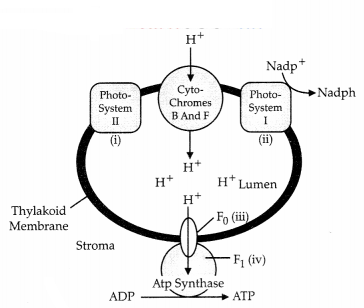
Answer:
Option (A) is correct.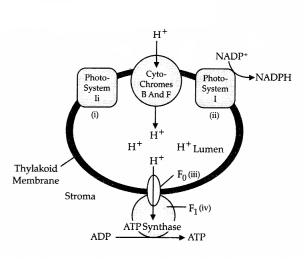
Question 9.
Plants of this group are diploid and well adapted to extreme
conditions. They grow seed bearing sporophylls in compact structures called
cones. The group in reference is: (1)
(A) Monocots
(B) Dicots
(C)
Pteridophytes
(D) Gymnosperms
Answer:
Option (D) is correct.
Explanation: Division gymnosperms are diploid and well adapted to extreme
conditions. They grow seed bearing sporophylls in compact structures called
cones, microsporophylls and megasporophylls are the male and female gametophyte
respectively.
Question 10.
Identify from the given diagram, the part which plays a role
in maintaining high osmolality of medullary interstitial fluid. (1)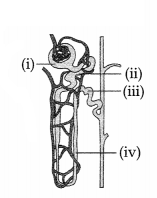
(A) (i)
(B) (ii)
(C) (ii)
(D) (iv)
Answer:
Option (D) is correct.
Explanation: Henle’s loops reabsorb water and sodium
chloride from the filtrate, received from glomerulus.
Question 11.
Viruses are noncellular organisms but replicate themselves
once they infect the host cell. To which of the following
kingdom do viruses
belong to? (1)
(A) Monera
(B) Protista
(C) Fungi
(D) None of the
above
Answer:
Option (D) is correct. As viruses are connecting link
between the living and non-living. So, they do not belongs to any of these.
Question 12.
Given below is the diagrammatic representation of a standard
ECG.
Which among the following wave represents the depolarisation of the
atria? (1)
(a) P wave
(b) QRS Complex.
(c) T Wave
(d) Both (a) and
(b).
Answer:
Option (A) is correct.
Explanation: P wave represent the
electrical excitation(depolarisation) of the atrium which leads to the
contraction of both the atrium.
QRS wave represent repolarisation T wave
represent repolarisation of the ventricles.
Directions: In the following questions, A statement of Assertion (A) is
followed by a statement of Reason (R). Mark the correct choice as: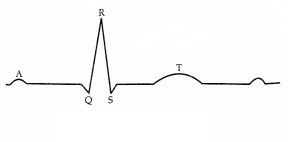
(A) Both Assertion (A) and Reason (R) are true and Reason (R)
is the correct explanation of Assertion (A).
(B) Both Assertion (A) and
Reason (R) are true but Reason (R) is NOT the correct explanation of Assertion
(A).
(C) Assertion (A) is true but Reason (R) is false.
(D) Assertion (A)
is false but Reason (R) is true.
Question 13.
Assertion (A): Factors for clotting of blood are also present
in the plasma in an active form.
Reason (R): Blood without plasma is called
serum. (1)
Answer:
Option (D) is correct.
Explanation: Factor like
thrombin and fibrinogen are found in an inactive form. Blood without blood cells
and clotting proteins is called serum.
Question 14.
Assertion (A): Leaves of monocot plants show reticulate
venation.
Reason (R): When the veinlets form a network, the venation is
termed as reticulate venation. (1)
Answer:
Option (D) is correct.
Explanation: Leaves of monocot plants shows parallel venation while leaves of
dicot plants show reticulate venation.
Question 15.
Assertion (A): All chordates are vertebrates.
Reason (R):
They possess a notochord, dorsal, hollow nerve cord and have pharyngeal gill
clefts in some stage of their life cycle. (1)
Answer:
Option (D) is
correct.
Explanation: All chordates are not vertebrates: Vertebrates have
vertebral column but protochordates and agnatha have notochord that is not
replaced by vertebral column.
Question 16.
Assertion (A): Some bryophytes are called liverworts.
Reason (R): They are called as liverworts because their sporophyte resembles
with liver lobes. (1)
Answer:
Option (C) is correct.
Explanation: Some
bryophytes are called liverworts because their gametophytic thalli resemble
liver lobes.
Section – B
Question 17.
Differentiate between chlorophyceae and phaeophyceae. (2)
Answer:
| Chlorophyceae | Phaeophyceae |
| (i) Chiefly fresh water in nature. Unicellular species are more. | Marine forms do not exist. |
| (ii) Chlorophyll ‘a’ and ‘b’ is present. Fucoxanthin is absent. | Chlorophyll ‘a’, ‘c’ and Fucoxanthin is present, which is responsible for the brown colour of the algae. |
| (iii) Reserve food is pyrenoid which contains protein besides starch. | Reserve food is laminaria |
Question 18.
(a) Identify the type of growth curve from the given
graph.
(b) Define the following (i), (ii) and (iii). (2)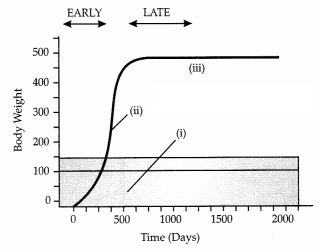
Answer:
(a) The given diagram shows ‘Sigmoid Growth Curve’.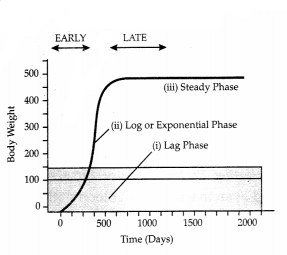
(b) (i) Lag phase: Growth is slow in the initial stage.
(ii) Exponential period of growth: It is second phase of maximum growth.
(iii) Stationary phase: When the nutrients become limiting, growth slows
down.
Question 19.
Label the given diagram and identify the given stage.
(2)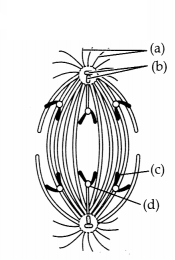
Answer: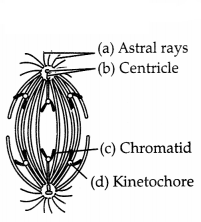
The following stage represents anaphase of mitosis.
Question 20.
Observe the diagram and answer the following. (2)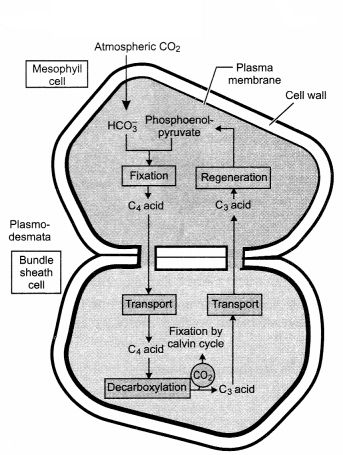
(a) Which group of plants exhibits these two types of cells?
(b) What is the
first product of C4 cycle?
Answer:
(a) C4 plants
such as sugarcane, maize etc., possess two types of cells i.e., bundle sheath
and mesophyll cell in Kranz anatomy.
(b) Oxaloacetic acid, a 4-carbon
compound is the first product of C4 cycle.
Question 21.
Auxin is a plant growth regulator which can be either
extracted from plants or synthetically prepared. (2)
Write the full form of
two synthetic auxins NAA and IBA. Write their uses ?
OR
Observe the given
diagram and answer the following questions.
(a) What are the reduced
co-enzymes produced in the respiration?
(b) In which part, the enzyme ATP
synthase is present?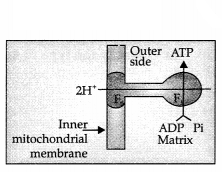
Answer:
Full forms of two synthetic auxins:
NAA:
Naphthalene Acetic Acid.
IBA: Indole Butyric Acid.
They are used in
agriculture to induce rooting in mango, flowering in cotton plants, to break
dormancy of seeds and to prevent the sprouting of potato tubers etc.
OR
(a) Reduced co-enzymes produced in the respiration are NADH2 and
FADH2.
(b) Enzyme ATP synthase is present in inner membrane of
mitochondria.
Section – C
Question 22.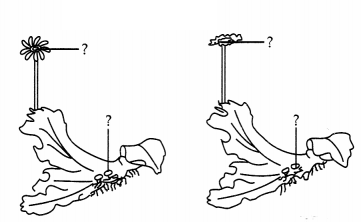
(a) Identify the given diagram and label the given parts. (3)
(b) Locate and
define Rhizoids.
Answer: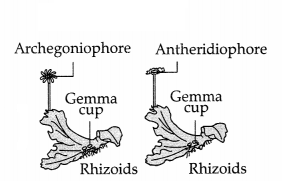
(b) Rhizoids are slender, unicellular or multicellular hair
like structures which penetrate in the moist soil and absorbs the water for the
plants.
Question 23.
How nerve impulses are conducted in non-myelinated nerves ?
(3)
Answer:
Conduction of nerve impulse through non-myelinated nerves:
- In the resting stage, the Na+ ions are pumped out from the axoplasm. It needs the energy to work normally.
- Thus, axon membrane is electronegative inside and electropositive outside, this is called resting potential. In this state, the nerve is said to be in polarised state.
- When the nerve fibre is stimulated, it causes electrochemical disturbance in the nerve fibre, a change in potential. This change is called an action potential.
- Thus, Na+ migrates into the axoplasm and Cl– ions diffuses out. Thus, negativity is increased outside and positivity is increased inside. This is called depolarisation.
- Depolarisation progresses along the nerve fibre in both directions from the point of stimulus
Question 24.
Cytokinesis is the cytoplasmic division of a cell at the end
of mitosis or meiosis, which bring about the separation into two daughter cells.
(3)
(a) How cytokinesis in plants differ from that in animals ?.
(b) With
reference to the cell types undergoing mitosis differentiate between animal
cells and plant cells
Answer:
(a) In animal cell, division of cytoplasm
takes place by cleavage while in plant cell, division of cytoplasm takes place
by cell-plate formation.
(b) In plants a new cell wall is fashioned between the new daughter cells, while in animal cells the cell membrane constricts to pinch the parent cell into daughter cells.
Question 25.
(a) Name the class of algae to which Laminaria belongs and
write it’s characteristic features.
(b) Label the given diagram. (3)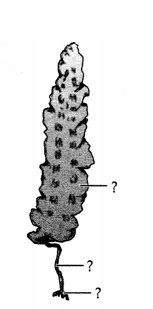
Answer:
(a) Laminaria belongs to class phaeophyceae.
Characteristic
feature of Phaeophyceae:
- In brown algae, fucoxanthin, chlorophyll a and c type are present.
- The reserve food is laminarin starch.
(b) 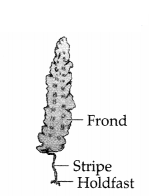
Question 26.
What is the correct way of writing a Botanical name ? Explain
with example. (3)
Answer:
- The biological name is written in two words.
- The first name is genus and the second represents species. They are printed in italics. Example Pisum sativum is the scientific name of the pea plant.
- Generic name begins with a capital letter (Pisum) and the species name begins with a small letter (sativum).
Question 27.
After fertilisation, ovules change into seeds and ovary
mature into fruits. Fruit consists of seeds and pericarp. The thick and fleshy
pericarp is three layered called epicarp, mesocarp and endocarp. (3)
(a)
Define simple fruits.
(b) How many types of simple fruits are found in
plants?
(c) Define composite or multiple fruits. (3)
OR
Frogs are a
type of amphibious vertebrate, which belong to the class Amphibia of phylum
Chordata. It can live on both land and in freshwater.
(a) (i) Name the three
types of respiration in the frog.
(ii) How does a frog respire during
hibernation?
(b) Webs are present between the toes of frog. Why?
Answer:
(a) The fruit that develops from the single simple or compound ovary
of a flower is called simple fruits. The simple fruits are of two types: Dry and
Succulent.
(b) (i) Dry fruits are of three types:
- Achenial
- Capsular
- Schizocarpic.
(ii) Succulent fruits are of three types:
- Berries,
- Drupes,
- Pomes.
(c) A composite or multiple fruits is a group of fruits which develop from
the different flowers of an inflorescence, e.g., Pineapple, mulberry, fig,
etc.
OR
(a) (i) All the three types of respiration found in frogs are-
Cutaneous respiration, Buccal respiration, Pulmonary respiration.
(ii) The skin of the frog is moist, slimy and highly vascularised which is especially useful for respiration in hibernation and aestivation. The oxygen of the atmosphere enters the thin film of skin moisture where it goes to the blood capillaries of the skin. The oxygen mixes with the blood and passes to the different organs of the body. The carbon dioxide formed in the body organs is taken up by the blood capillaries to the skin from where it diffuses out into the air.
(b) The webs are present between the toes because these act as paddles when the frog is swimming.
Question 28.
Comment on the cartwheel structure of centriole. (3)
Answer:
Centrosome is a small naked organelle found in the cytoplasm of an
animal cell near the outer surface of the nucleus. It consists of two bundles of
microtubules called centrioles that lie at right-angles to each other.
Centrioles are short cylinders with a 9+0 pattern of microtubular triplets. This
means, a centriole possess a whorl of 9 peripheral fibrils. This fibrils are
absent in the centre, hence the arrangement is called 9 + 0. Each fibrils are
made of 3 sub-fibres. There is a proteinaceous hub in the central part of a
centriole. The hub is connected to the triplets via radial spokes.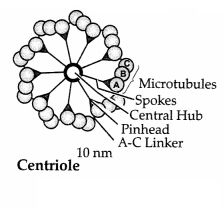
Question 29.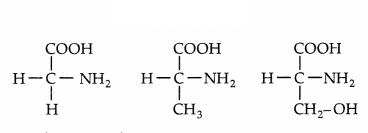
(a) Name the given structures of amino acids. (4)
OR
What are amino
acids?
(b) Answer the following questions with reference to amino acids:
(i) Draw the structures of amino acids in solutions of different pHs.
(ii)
What is zwitter ionic form of amino acid?
(c) Classify amino acids on the
basis of a number of amino group and carboxylic group. Give example for each
type.
Answer:
(a) Glycine, alanine, serine.
OR
They are organic
acids having both carboxylic acid group (COOH) and amino group (NH2)
generally attached to α-carbon. Carboxylic group provides an acidic property to
the amino acid while amino group gives it a basic reaction. The α-carbon also
bears a variable hydrocarbon or alkyl group R and hydrogen.
(b) (i) In
solutions of different pHs the structure of
amino acids changes as follows
:
(A) Acidic Medium (B) Neutral Medium (C) Basic Medium
(ii) At specific pH when amino acid carries both positive and negative charge
equally and net charge on it is zero , it is known as zwitter ionic form of
amino acid.
(c) Depending upon the number of amino group and carboxylic
groups, amino acids have been classified as:
- Neutral amino acids: The neutral amino acids have one amino group and one carboxylic group e.g., alanine, glycine.
- Acidic amino acids: The acidic amino acids have an extra carboxylic group e.g., glutamic acid, aspartic acid.
- Basic amino acids: The basic amino acids have an additional amino group e.g., lysine, arginine.
Question 30.
On the basis of structure and location, there are three types
of tissue systems. (4)
These are the epidermal tissue system, the ground or
fundamental tissue system and vascular or conducting tissue system.
(a) What
are open vascular bundles?
(b) What are conjoint vascular bundles?
(c)
What does the vascular tissue system consist of?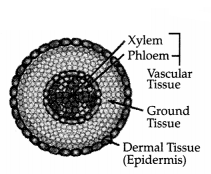
OR
The anatomy of monocot root is similar to the dicot
root in many respects. It has an epidermis, cortex, endodermis, pericycle,
vascular bundles and pith. As compared to the dicot root which have fewer xylem
bundles there we usually more than six (polyarch) xylem bundles in the monocot
root.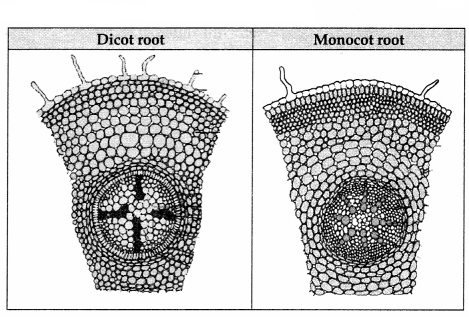
(a) The parenchymatous cells which lie between the xylem and Phloem are?
(b)
What is a stele?
(c) Differentiate monocot and dicot roots. On the basis of
xylem bundles.
Answer:
(a) Open vascular bundles are vascular bundles in
which cambium is present between phloem and xylem.
(b) In conjoint vascular bundles, the xylem and phloem are jointly situated along the same radius of vascular bundles.
(c) Vascular tissue system consists of xylem and phloem.
OR
(a)
Conjunctive tissue.
(b) All tissue on the inner side of the endodermis such as pericycle, vascular bundles and pith constitute the stele.
(c) Dicot roots have fewer xylem bundles, there are more than six (polyarch) xylem bundles in the monocot root.
Section – E
Question 31.
Concerning the given table, study the different blood groups
and fill in the donor-recipient compatibility. (5)
OR
Study the given table and name the substances removed from the body by
each part of the nephron.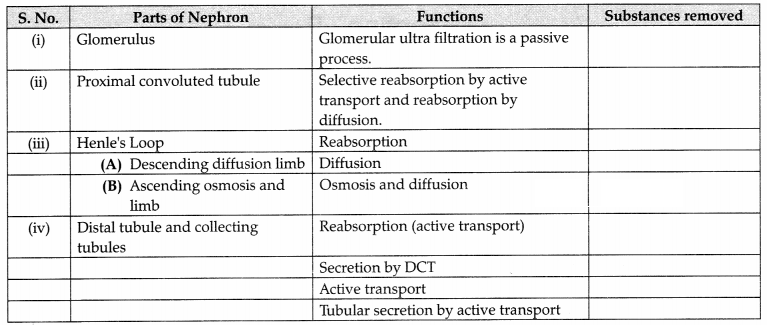
Answer:
OR
| S.No. | Parts of Nephron | Functions | Substances removed |
| (i) | Glomerulus | Glomerular ultra filtration is a passive process. | |
| (ii) | Proximal convoluted tubule | Selective reabsorption by active transport and Reabsorption by diffusion | Reabsorption of glucose, amino acids, sodium, potassium, chlorides, water, etc. |
| (Hi) | Henle’s Loop | Reabsorption | NaCI |
| (a) Descending limb | Diffusion | H2O | |
| (b) Asending limb | Osmosis and Diffusion | Urea, K+ Na+ and Cl– | |
| (iv) | Distal tubule and collecting tubules | Reabsorption (active transport) | Sodium ions |
| Secretion by DCT | K+ ions | ||
| Active Transport | K+, H+, Uric acid, NH3 etc. | ||
| Tubular secretion by active transport | Pigments and drugs. |
Question 32.
Describe briefly the regulation of kidney function by the
following. (5)
(a) ADH,
(b) ANF,
(c) Renin
OR
A person has severe
pain and inflammation in his joints. He is diagnosed with arthritis disease. On
the basis of this condition, answer the following questions:
(a) If the
inflammation is diagnosed in the synovial joint and produces too much synovial
fluid. What type of arthritis the patient may be suffering?
(b) What may be
the possible impact on the joints of the patient?
(c) What may be the
possible cause of the disease?
Answer:
Regulation of Kidney:
(a) ADH:
Antidiuretic hormone (ADH) is secreted by the hypothalamus of the brain and
released into the blood from the posterior lobe of the pituitary gland. The
release of ADH is triggered when an osmoreceptor in the hypothalamus detects an
increase in the osmolarity of the blood above a set point of 300 osmo
mL-1 In this situation the osmoreceptors cells also promote thirst.
It increases the reabsorption of water in the DCT and collecting duct.
(b) ANF: Atrial natriuretic factor is another hormone which opposes the regulation by RAAS. The walls of the artery of the heart release ANF in response to an increase in blood volume and pressure. ANF inhibits release of renin from the JG cells and thereby inhibits NaCl reabsorption by the collecting duct and reduces aldosterone release from the adrenal gland. Thus ADH, RAAS and ANF regulate the function of the kidneys. As a result, they control body fluid osmolarity, salt concentration, blood pressure and blood volume.
(c) Renin: The smooth muscle cells of both the afferent and efferent
arterioles are swollen and contain dark granules. These cells are called
juxtaglomerular cells. A fall in glomerular blood flow or glomerular blood
pressure activate the JG cells to release renin. Renin converts angiotensinogen
in blood into angiotensin II. The later increases blood pressure. Angiotensin
also stimulates the secretion of aldosterone by the adrenal cortex, thus
infusing the reabsorption of sodium ions by the DCT and that of water through
collecting ducts.
OR
(a) Rheumatoid arthritis, is a condition of
inflammation in synovial joints which is characterised by too much synovial
fluid.
(b) Immovable joint and erosion of cartilages.
(c) Auto-immune
reaction.
Question 33.
Explain the factors affecting photosysnthesis as:- (5)
(a)
External Factors.
(b) Internal Factors.
OR
It is known that some
varieties of wheat are sown in autumn but are harvested around next
mid-summer.
(a) What could be the probable reason for this?
(b) Which
plant hormone can replace the cold treatment?
(c) Gibberellic acid is named
after which fungus?
Answer:
(a) External factors:
(i) Light: The
quality, intensity and duration of light received by plants greatly influences
the rate of photosynthesis. The quality of light influence photosynthesis as
blue and red regions of the visible spectrum are the most effective. Green light
has minimum effect. When sufficient intensity of light is available, they starts
performing photosynthesis. Rate of photosynthesis increase proportionately with
an increase in light intensity till plants achieve light saturation point.
Beyond this point photosynthesis does show any change. Longer exposure to
continuous light favours good photosynthesis.
(ii) Carbon dioxide: CO2 concentration in atmosphere act as a limiting factor. An increase in CO2 cone, upto 0.1% shows an increase in photosynthesis. Higher cone. Becomes toxic and inhibit the rate of photosynthesis.
(iii) Oxygen: High concentration of oxygen has an inhibitory effect on photosynthesis in C3 plants, because RuBP oxygenase becomes more active resulting in photorespiration.
(iv) Water: Its photooxidation supplies H+ for the reduction of NADP. The reduced NADPH is used in the reduction of CO2 in the Calvin cycle. It also donates the electrons to P680 in non-cyclic photophosphorylation.
(e) Temperature : Rate of photosynthesis doubles with every 10°C rise in
temperature till the optimum value is achieved. An increase in temperature above
30°C results in a fall in the rate of photosynthesis.
The optimum temperature
for photosynthesis in C3 plants is 10 – 25°C and in C4 plants it is
30- 45°C. ‘
(b) Internal factors:
(i) Chlorophyll content: Chlorophyll is essential
for cyclic and non-cyclic photophosphorylation and reduction of NADP, the
assimilatory power, used to fix and reduce CO2 in Calvin cycle.
(ii) Leaf anatomy: The important anatomical features that influence photosynthesis include the thickness of cuticle, stomatal index, distribution of stomata, degree of opening of stomata, size and distribution of intercellular spaces, and number and distribution of vascular strands. Kranz anatomy of C4 plants increases the efficiency of photosynthesis.
(iii) Age of leaf : As leaf develops, the rate of its photosynthesis
increases gradually reaching maximum when the leaf becomes fully matured. Rate
of photosynthesis decreases with age of the leaf.
OR
(a) Some varieties of
wheat are sown in autumn but are harvested around next mid-summer. They take
over one full year of growing season for the completion of their vegetative
growth period and then initiate flowers and fruits. This is because, they
receive low temperature without water which enables them to reach vegetative
maturity. They resume growth in spring and bear flowers and grains towards
mid-summer.
(b) Gibberellic acid treatment can replace the cold treatment and can induce flowering early.
(c) Gibberellic acid is named after a species of fungus – Gibberella Fujikuroi